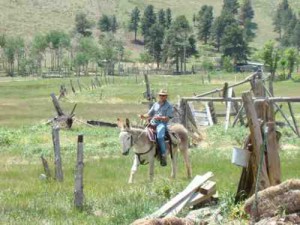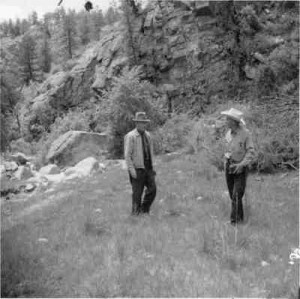Column by George Sibley
Politics – January 2009 – Colorado Central Magazine
Only that day dawns to which we are awake.
There is more day to dawn. The sun is but a morning star.–Henry Thoreau, Walden
RONALD REAGAN had one thing right when he was elected in 1980: it was “morning in America.”
Unfortunately for America, and probably the planet, his message was — roll over and go back to sleep. Turn off that alarm clock and pretend the morning that began to dawn in 1973 never happened. Take down those silly solar panels.
And we — that collective “we” we call “America,” which Churchill said will always do the right thing, after trying everything else — were happy to comply. The price of petroleum went back down (never mind that it was no longer our petroleum), the Dow went up and up (never mind it was increasingly not our money), the recession ended, the hostages came home — et cetera. Go back to sleep, dream again that old American Dream; those 70s events were just a nasty little half-waking nightmare….
But now we’re being woken up again, and it’s still morning in America, but barely. It’s getting closer to high noon, and everything that was staring us in the face on that morning which began in 1973 is still there, but farther along and worse. The good news is that this time we didn’t elect the guy who told us we could go back to sleep. The bad news will come if or when the guy we did elect is actually courageous enough to tell us what the workday looks like.
I’m not going to run through the litany of specific economic, social, environmental and energy-related challenges we are facing “this morning.” If you are reading this, you probably already know that litany pretty well — a litany that can now be most accurately summarized not as a challenge to “revitalize” or “recover” the economy, but to seriously set about the task of creating a new “real economy” that works within the long-term possibilities and limitations inherent to the planet, rather than highgrading and exploiting the planet’s short-term potential — an economic option that’s nearing exhaustion.
“Change” was a soundbite theme in the recent election, but it often sounded like we had a choice: change or no change, I guess. However, the raw fact “this morning” brings is that the changes are upon us, and the way we do things will be changed, regardless. Our choice is to decide whether to try to guide and direct the change in order to smooth and soften its impact, or to just let it roll over us.
There is every indication at this point that the president-elect — a politician — is going to move as cautiously as we will let him in addressing the changes that are upon us. His appointments to date are disappointments for many of the people who really went out and worked hard to get him elected, and he will have to address that at some point, because an army of political workers scorned can be far angrier than a lover scorned.
BUT I AM HOPING that he really knows what he is doing, that there is a healthy madness to his method — the madness being the ridiculous notion that the political pendulum of left-to-right-to- left-to-right can somehow be damped down to move less violently through the center region where it might actually be possible — here’s the mad vision — to get some things done that both the left and right, liberals and conservatives, progressives and regressives, will get invested enough in to want to keep them as achievements rather than see them knocked down in the next violent pendulation.
That mad idea will not be served by a cautious middle-of-the-road approach — that’s a passive “center” and not the center whereof I speak. If we are going to have a truly bipartisan governance that actually gets some governing done, which seems to be his goal, then he will have to work from the “radical center.”
The radical center: I’ve written about it before in this column. It’s a term that came out of the ranching west, to the best of my knowledge, from ranchers and environmentalists who became tired of the same old confrontations, and acknowledged that in some respects the land itself was suffering as much from their political standoff as from anything the ranchers were or were not doing. Through organizations like the Quivira Coalition in the Southern Rockies and collaborations like the Malpai Borderlands group down on the far southern border of Arizona, New Mexico and Old Mexico, cultural protagonists decided to edge up to the middle rather than staying comfortably out at their extreme postures, diversifying their thinking and nurturing what might be the most survival-oriented trait of all: an open-minded willingness to try things out. Both Quivira and the Malpai Group have demonstrated outstanding achievements in improving both range and cattle production through creative management strategies that are pleasing to all sides.
We need that kind of collaborative thinking applied a lot more broadly. Here in Central Colorado, we need that kind of collaboration between what I would call Communitarian Democrats and Main Street Republicans. It remains a mystery to me, why Main Street Republicans continue to align themselves with Wall Street Republicans, who do their best to (nothing personal, guys) screw the Main Streeters along with everyone else (equal-opportunity screwers). But when the Communitarian Democrats and Main Street Republicans start working together — while staying true to their basic principles — the way environmentalists and ranchers have in the Quivira Coalition, we will start to see some flint-and-steel creativity in our communities.
THIS HAS ACTUALLY HAPPENED in the past. The best example is probably the Rural Electrification Administration in the 1930s (the last time things were this bad). The REA was started in 1935 as an extension of the New Deal’s make-work programs, but it didn’t work that way because electric systems required more technical knowledge than pure muscle. So around 1936, REA chief Morris Cooke persuaded Roosevelt to change it to a more “capitalistic” venture: Rural people who wanted electricity (and they all did, because the towns already had it) could form a cooperative — which would be called “socialism” everywhere but in rural America where the Grangers had been creating co-ops for fifty years — and the government would do what the capitalists wouldn’t or couldn’t do; it would loan them the capital and expertise to create their own electric systems.
That was something Main Street and Farm Republicans could live with as well as Democrats (rare in the rural West). It wasn’t charity; it was just a creative combination of money capital, knowledge capital, and sweat equity, and it got the rural areas electrified. Most of the loans were paid back to the government, and the program caused lifelong Main Street Republicans like George Aiken of Vermont to break with the Wall Street Republicans.
“It is probably true” Aiken said “that extension of lines into these farming areas would not immediately pay substantial dividends on inflated valuations. But the cooperative, working under the REA program, does not inflate its capital structure, does not pay high official salaries, does not hire high priced attorneys, does not maintain expensive legislative lobbies, does not pay tribute to holding companies and does not employ high pressure and expensive publicity methods to expound its virtues.”
IF PRESIDENT OBAMA really wants to work the “radical center,” he would do well to think of similar strategies. How about, for example, a new REA: a Regional Energy Administration? The electric power industry’s own R&D organization, the Electric Power Research Institute (EPRI), has said that decentralization of the power structure — distributed generation and micropower at the regional and local levels — is the way of the future. Most of our renewable energy resources are decentralized by nature, and new technology has made “micropower” gas and wind turbines more efficient than big centralized “economy of scale” plants, once line losses are figured in.
I’m working on an Energy Action Plan process here in the Upper Gunnison, and most of our best ideas are going to require some up-front money, which will not be available from local and state budgets that have to be balanced, even in recessionary times. But “stimulus money” from the federal government (which can go into debt, obviously) could empower a literal “thousand points of light” across the nation, or maybe a million or so, under the same conditions as provided by the original REA. Long-term loans would have to be repaid, so it gives the next generation the new energy future it will need without piling more deferred debt on them.
This is not socialism; it’s just good capitalism that Main Street Republicans and Rancher Republicans should be able to appreciate as much as us old tax- and-spend liberals. We’re not a pack of socialistic Wall Street Republicans, looking for handouts; just make it possible for us to get the Big Transition going, and we’ll pay it back out of what we save!
I hope Barack Obama is thinking this way, but I begin to fear that he is thinking bipartisan between Washington left and right, when the real challenge might be bipartisan between Washington politics and the rest of us.
Meanwhile — good morning, America!
George Sibley writes from Gunnison, which has never claimed to be in Colorado’s “Banana Belt.”


